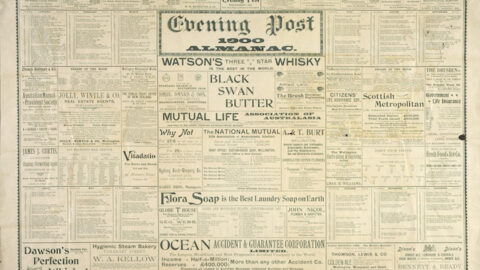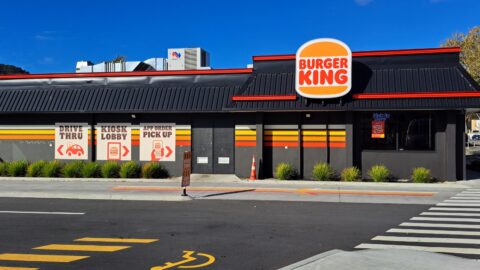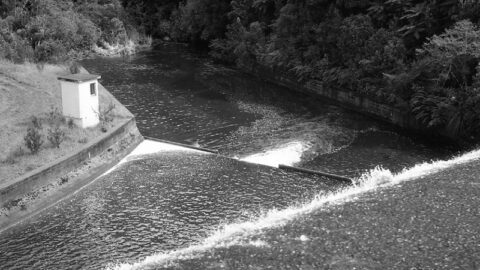A DAY’S EXCURSION
WELLINGTON TO WAINUIOMATA
SPRING BLOSSOMS AND CONCRETE DAMS
WORK AT SOLOMON’S KNOB
The way from Wellington to Wainuiomata Reservoir just now affords more than its usual amount of interest for any lover of nature whose poetic proclivities enable him to enjoy the natural pictures of green and yellow which the landscape presents.
If, in addition, he possesses a utilitarian mind that can appreciate the signs of progress and activity that mark the Wainuiomata and its approaches at this time, he is in doubly happy case.
Yesterday’s trip to the big reservoir was made under the perfect conditions of a bright sun and a soft breeze, and the whole valley from the Upper Hutt to Petone, with the harbour from the near beach to Wellington, was one uninterrupted blaze of glinting sunshine.
Viewed from the steep track that scales the dividing range, the Lower Hutt and Petone Valley made a magnificent picture, with the yellow blaze born of an early spring splashed about the green landscape.
Gear Island, a delta in the mouth of the Hutt River, seemed encircled by a ribbon of gleaming silver, and near the foot of the big hill, the Waiwetu, a narrower and more pellucid stream, ran its straighter course to the most easterly part of the harbour.
Between these were nestled the homes of the settlers, with paddock after paddock of lush grass surrounded by gorse hedges in full bloom, and here and there a ploughman’s team moving slowly up and down.
POINTS OF INTEREST
But to some points of interest on the journey. The Hutt Main Road, once the muddiest and most vexatious highway this side of Taihape, is now in really good winter order and a monument to the foresight of the civic and governmental authorities who instituted the board of control that has transformed the former sludge channel into the fine thoroughfare it is today.
Along the harbour front near Petone, the “going” is still good, but the Hutt Park railway line is steadily depreciating through lack of use, and the lands which city workers are understood to be yearning to reach by rail remain unsettled. A little way beyond the terminus of the line is Gear Island, across which runs a pipe bridge bearing the city water main from Wainui. It is near this spot that the new pipe and traffic bridge is being built by joint subscription of several local bodies.
Many months were wasted in preliminary negotiations before the work of erection commenced. It seems a great many months since they were concluded and the contractor arrived from a northern town to begin construction. No doubt a good deal of preliminary labour has been done, but it must be much more real than apparent.
Yesterday, as The Post reporter passed by, there were two concrete walls, one on each side of the river, and a couple of piles somewhere between the two. A donkey-engine had been driving one, working a “monkey,” but apparently something went wrong, and fixing it was still a problem a quarter of an hour later.
“Take the strain, Frank; take the strain!” was the cry of the man on the monkey platform to the engine-driver. No doubt the engine-driver did take it, but progress seemed so slow that the observer decided “the strain” must be a goods train, in which case it would be quicker to walk—so he did.
The long and serpentine track to the top of the hill was in good order, but on the other side, its condition was poor, chiefly because of the more shaded nature of the Wainui Valley, the poorer natural drainage, and possibly the greater average rainfall in that vicinity. The extraordinary traffic occasioned by the large construction work now in progress at Wainuiomata has tested the road to a great degree, and in some places, its weak points have been made manifest.
On the narrow track up the valley of the waterworks, the road is at its worst, but it was being repaired yesterday, and now that winter is over, more stable road surfaces are anticipated.
WAINUI IS WET
Next to the sandflies, the most persistent thing at Wainuiomata is the rain.
A bright young labourer asserted that there had not been three successive fine days in the last four months; and in case he might be thought to have exaggerated, he added that “it was a square dinkum chat he was giving.”
A statistical support for his statement is given by the observations of the City Council’s custodian, who has noted twenty-six showery days out of the thirty-one days of July.
These experiences to some extent have delayed the work of putting in the big dam at Solomon’s Knob, but fair progress has been made in spite of the drawbacks, and it is hoped that in twelve months’ time the contract will be very near completion.
THE WORKS’ PRESENT POSITION
In addition to the labours already incidentally noted in this article, many others have been carried out. The tram rails have been put down from the receiving shed right up to Solomon’s Knob — a distance of two miles — and a long line of steel pipes (some eighteen inches in diameter) has been laid from the Knob to a point beyond the mouth of the old reservoir.
At present, these pipes bear away the muddied water from the works, but eventually they will carry a separate head of water from the new dam to the city; constituting, in fact, the second arm of the duplicated main which Wellington has been promised.
The greatest labours, however, have been done at Solomon’s Knob. That eminence has fallen from its high estate, even as did the great potentate whose name it bears, and there is now a big cavity of about 300 feet in length and 65 feet in width, where once the spur struck down to the creek.
In this, all has been made ready for the great dam, and two-thirds of the concrete foundations are in already.
Yesterday was to have seen a great deal more done to this branch of the undertaking, but just as the flywheel of the engine was being put into action to move the necessary machinery, a wheel of the crankshaft broke.
A new wheel is to be installed today, and it is likely that by the time this article is printed the whole of the foundations will be filled up.
A BIG DAM
The dam is to be 540 feet long, and the excavations that are being made run 28 feet and 30 feet in depth, with varying widths. The foundations go down to the bedrock, and their width ranges from 5 feet 7 inches to 8 feet.
The foundations for the tower-house, in which the water is to be turned on or off as required, are completed already. An aerial wire, to which is attached a hopper that carries about two tons of gravel and drops them at any specified spot, has considerably facilitated the carrying out of this portion of the contract.
This contrivance, which is colloquially known as a “flying fox,” is one instance of practical philosophy profitably applied to everyday requirements. By its use, a piece of work may be done in one day that under the old conditions could not have been carried through in a week.
All the concrete work is being reinforced with steel rods, and the pronouncements of the works foreman and the clerk of works on the quality of the dam is that it is strong enough to hold up the water and the Tower of Babel together.
The bottom of the foundation — “curtain wall” is the technical term — is 459 feet above sea level.
INCIDENTAL ITEMS
The steel pipes which were used for the new main were made in New Zealand, at Auckland, by the firm of Nephau Fergusson. Spiral pipes, supplied by the same firm, were manufactured at Wanganui. The company has supplied the pipes for some big contracts in America, and its practice is to manufacture them as near to the works locality as may be convenient.
There are 65 hands employed on the contract at present, inclusive of several tradesmen. A galvanised iron shed of large dimensions covers the machinery at the Knob, and there are separate buildings in the vicinity for use by the carpenters and blacksmiths.
In the past, the contractors have had some difficulty in getting good navvies, but just now they have all the hands they need. It is estimated that the plant in use for the contract is worth between £3000 and £4000.
The “flying fox,” which carries some two tons of gravel at a time, shifts about 300 feet per minute. The clerk of works, representing the City Council, is Mr Hardy, who filled a similar position when the new dam at Karori was under construction. Mr Thomas, the contractors’ foreman of works, filled a like position for the firm which carried out the Karori contract.






